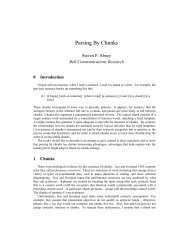The English Noun Phrase in its Sentential Aspect - Vinartus
The English Noun Phrase in its Sentential Aspect - Vinartus
The English Noun Phrase in its Sentential Aspect - Vinartus
You also want an ePaper? Increase the reach of your titles
YUMPU automatically turns print PDFs into web optimized ePapers that Google loves.
2. INFL IN THE NOUN PHRASE 272 In <strong>in</strong> the <strong>Noun</strong> <strong>Phrase</strong><strong>The</strong>re are numerous languages <strong>in</strong> which the noun phrase is much more likethe sentence than it is <strong>in</strong> <strong>English</strong>, <strong>in</strong> that the noun phrase <strong>in</strong> these languageshas one or both or the follow<strong>in</strong>g properties: (1) a possessed noun agreeswith <strong>its</strong> subject <strong>in</strong> the same way that the verb agrees with <strong>its</strong> subject,and (2) the possessor receives the same case as the subject of the sentence,rather than a special genitive case. Schematically:(22) [ NP NP i -nom/erg N-agr i ... ]Both of these phenomena po<strong>in</strong>t to the existence of an AGR <strong>in</strong> the nounphrase: we see it overtly, and we see <strong>its</strong> eects <strong>in</strong> the case assigned to thepossessor. If there is an AGR, then the m<strong>in</strong>imal assumption is that there isan In-like position which it occupies. If not, we must nd an explanationfor why AGR occupies dierent positions <strong>in</strong> the sentence and noun phrase.<strong>The</strong> only alternative to postulat<strong>in</strong>g a noun-phrase In which suggests<strong>its</strong>elf is that AGR is adjo<strong>in</strong>ed to N 0 :(23) NP/ \NP N'|N/ \N AGRNot only is this less desirable a priori, because it makes it more dicultto account for the constra<strong>in</strong>ts on the positions <strong>in</strong> which AGR appears,but it is also empirically <strong>in</strong>adequate. Namely, it is reasonable to supposethat the conguration illustrated <strong>in</strong> (23), with \V" substituted for \N", isthe structure of object agreement markers: subject agreement markers aregenerated <strong>in</strong> In, object agreement markers <strong>in</strong> the verb. If NP lacks an Inlikeposition, we predict that it will only have object agreementmarkers. Infact, <strong>in</strong> Yup'ik, nouns have both subject and \object" agreement markers. 4Thus the hypothesis under which (23) illustrates the only position for AGR<strong>in</strong> the noun phrase is empirically <strong>in</strong>adequate, and we are forced to assumean In-like position <strong>in</strong> the noun phrase.Let us beg<strong>in</strong>, then, by consider<strong>in</strong>g the facts from Yup'ik <strong>in</strong> more detail.4 <strong>The</strong> \object" agreement is not agreement with an actual object I have called it\object" agreement because it is morphologically identical to object agreement <strong>in</strong> thesentence. See immediately below, section 2.1.



